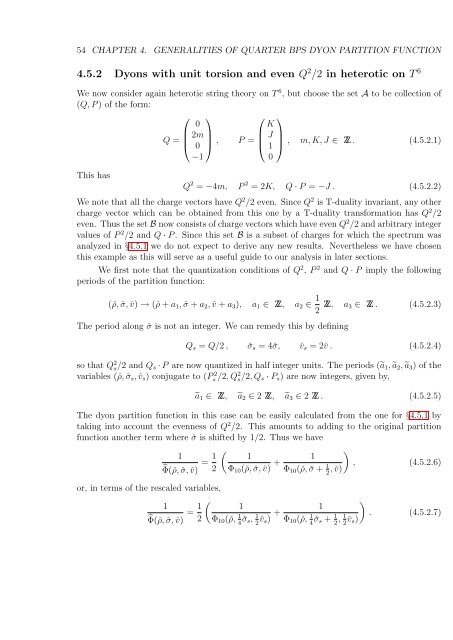PHYS08200604018 Shamik Banerjee - Homi Bhabha National ...
PHYS08200604018 Shamik Banerjee - Homi Bhabha National ...
PHYS08200604018 Shamik Banerjee - Homi Bhabha National ...
Create successful ePaper yourself
Turn your PDF publications into a flip-book with our unique Google optimized e-Paper software.
54 CHAPTER 4. GENERALITIES OF QUARTER BPS DYON PARTITION FUNCTION<br />
4.5.2 Dyons with unit torsion and even Q 2 /2 in heterotic on T 6<br />
We now consider again heterotic string theory on T 6 , but choose the set A to be collection of<br />
(Q, P ) of the form:<br />
⎛ ⎞ ⎛ ⎞<br />
0<br />
K<br />
Q = ⎜ 2m<br />
⎟<br />
⎝ 0 ⎠ , P = ⎜ J<br />
⎟<br />
⎝ 1 ⎠ , m, K, J ∈ Z . (4.5.2.1)<br />
−1<br />
0<br />
This has<br />
Q 2 = −4m, P 2 = 2K, Q · P = −J . (4.5.2.2)<br />
We note that all the charge vectors have Q 2 /2 even. Since Q 2 is T-duality invariant, any other<br />
charge vector which can be obtained from this one by a T-duality transformation has Q 2 /2<br />
even. Thus the set B now consists of charge vectors which have even Q 2 /2 and arbitrary integer<br />
values of P 2 /2 and Q · P . Since this set B is a subset of charges for which the spectrum was<br />
analyzed in §4.5.1 we do not expect to derive any new results. Nevertheless we have chosen<br />
this example as this will serve as a useful guide to our analysis in later sections.<br />
We first note that the quantization conditions of Q 2 , P 2 and Q · P imply the following<br />
periods of the partition function:<br />
(ˇρ, ˇσ, ˇv) → (ˇρ + a 1 , ˇσ + a 2 , ˇv + a 3 ), a 1 ∈ Z, a 2 ∈ 1 2 Z, a 3 ∈ Z . (4.5.2.3)<br />
The period along ˇσ is not an integer. We can remedy this by defining<br />
Q s = Q/2 , ˇσ s = 4ˇσ, ˇv s = 2ˇv . (4.5.2.4)<br />
so that Q 2 s/2 and Q s · P are now quantized in half integer units. The periods (ã 1 , ã 2 , ã 3 ) of the<br />
variables (ˇρ, ˇσ s , ˇv s ) conjugate to (P 2 s /2, Q 2 s/2, Q s · P s ) are now integers, given by,<br />
ã 1 ∈ Z, ã 2 ∈ 2 Z, ã 3 ∈ 2 Z . (4.5.2.5)<br />
The dyon partition function in this case can be easily calculated from the one for §4.5.1 by<br />
taking into account the evenness of Q 2 /2. This amounts to adding to the original partition<br />
function another term where ˇσ is shifted by 1/2. Thus we have<br />
1<br />
̂Φ(ˇρ, ˇσ, ˇv) = 1 2<br />
(<br />
)<br />
1<br />
Φ 10 (ˇρ, ˇσ, ˇv) + 1<br />
Φ 10 (ˇρ, ˇσ + 1, ˇv) , (4.5.2.6)<br />
2<br />
or, in terms of the rescaled variables,<br />
1<br />
̂Φ(ˇρ, ˇσ, ˇv) = 1 (<br />
)<br />
1<br />
2 Φ 10 (ˇρ, 1 ˇσ 4 s, 1 ˇv 2 s) + 1<br />
Φ 10 (ˇρ, 1 ˇσ 4 s + 1, 1 ˇv . (4.5.2.7)<br />
2 2 s)

















